A Guide to Banana Varieties Around the World
There are thousands of banana varieties to know and love—here are a few.
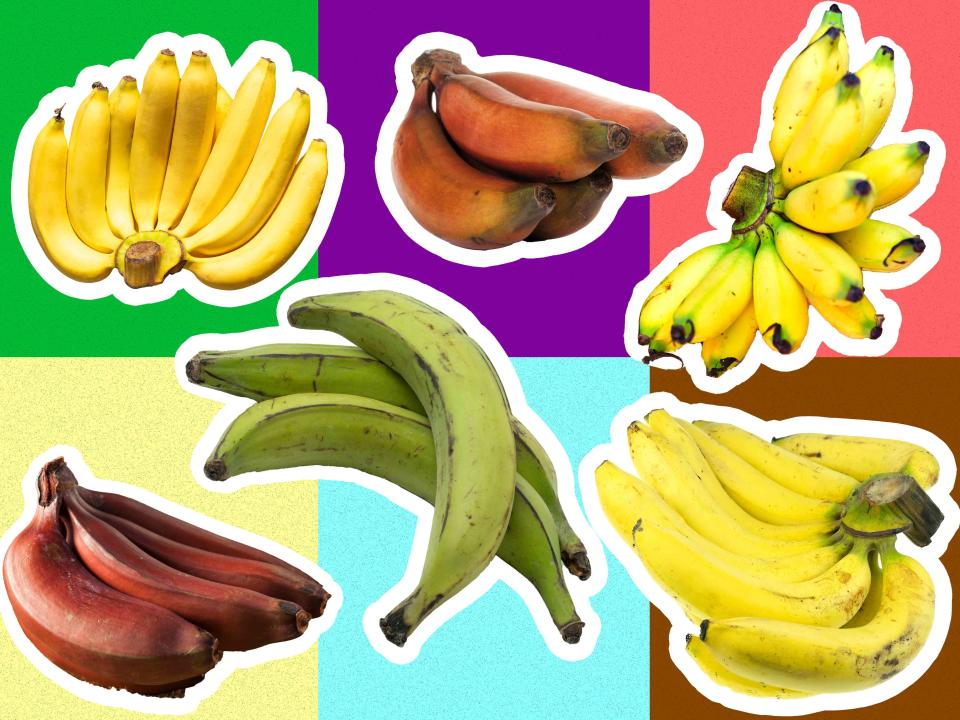
Getty Images
The more you think about bananas, the stranger a concept they seem: Almost all bananas are grown in tropical climates, yet they feel as much a staple in North American grocery stores as our native apples. But unlike apples, there’s only one variety of banana available to most people in the United States: the Cavendish, a slender, slightly curved banana with a cheerful shade of yellow.
Around the world, however, there are thousands of other banana varieties—they just aren’t readily available outside of their native growing areas. Below, we’ll take a look at some of those cultivars, including ones that you can find in the U.S. (if you know where to look!) and others that you should add to your list if you ever find yourself somewhere tropical. Trust me, they’re worth seeking out.
What Exactly Are Bananas, Anyway?
Botanically speaking, bananas are berries. A single banana develops from one pollinated flower containing one ovary, and the mature fruit contains three distinct parts: an outer skin, a fleshy middle, and an innermost layer containing several seeds. Banana plants belong to the biological genus Musa, which contains 83 flowering plants, including bananas and plantains. Banana “trees” are technically not trees; rather, they’re herbaceous plants that can grow up to 40 feet tall. Instead of a tree’s signature trunk or woody stem, banana plants’ stems are composed of multiple individual leaf stalks.
Bananas are indigenous to tropical portions of India, Southeast Asia, and northern Australia, though this range specifically speaks to Musa acuminata—the Dwarf Cavendish—which is the modern banana’s wild ancestor. Scientists concur that the domesticated bananas we are familiar with today first originated in Papua New Guinea approximately 7,000 years ago. People brought bananas with them on their travels, and, over the course of several centuries, spread the fruit across the globe. Sailors introduced bananas to Africa for trade, and in turn European colonizers imported the fruit to the Americas. Today, bananas grow in Central and South America, Africa, and their native Indomalaya and Australia.
A Brief History of Banana Consumption in the U.S.
Americans have been importing bananas since 1870, when the American businessman Lorenzo Dow Baker loaded 160 bunches of bananas from Jamaica onto his ship. After cashing in the fruit in Boston for $6,400—which, adjusted for inflation, is more than $150,000 today—Baker quickly formed the Boston Fruit Company. Recognizing that bananas could be picked while firm, stored in a cool and dry cargo hold during transit, and be perfectly ripe by the time they arrived at American ports, Boston Fruit Company created the banana trade’s business model that is still in use today. This, combined with consumers’ willingness to pay $2 (approximately $50 today) per bunch of bananas, proved that bananas meant big business.
To establish a national presence, northeast-based Boston Fruit Company merged with southeast-dominant Tropical Trading and Transport Company in 1899, forming United Fruit Company. United Fruit Company further entrenched Boston Fruit Company’s vertically-integrated business model, and coupled it with the robust Central American rail network built by and inherited from Tropical Trading and Transport Company based in New Orleans. Doing so firmly established the lasting infrastructure necessary to grow, pick, transport, market, and sell the banana as an everyday commodity in the United States.
Through aggressive marketing and campaigning stateside, fruit companies were able to cement the banana as an affordable American staple, and the fruit has since become a go-to snack and common baking ingredient in many households. Today, bananas are deeply ingrained in our everyday lives, so much so that bananas are consistently the most popular fresh fruit purchased in the United States.
Editor’s Note: While a deep-dive on the often fraught industry of bananas is beyond the scope of this article, we recommend reading Dan Koeppel’s excellent book Bananas: The Fate of the Fruit That Changed the World for an in-depth look at the often insidious role of colonization and globalization in popularizing the fruit.)
How the Banana Industry Led Us to a Singular Banana Variety
As more and more Americans expected consistency and convenience at their fingertips, the fruit industry realized it would need to standardize the bananas available for purchase. Sweet, creamy, and slightly floral, the Gros Michel banana—the precursor to the Cavendish—was the perfect cultivar. Beyond its exceptional flavor, the Gros Michel’s ability to withstand long ocean voyages without being easily bruised or damaged also made it an excellent candidate for international commerce.
Because the Gros Michel is a sterile variety of banana that virtually lacks seeds, cultivating the banana requires cloning it through asexual propagation. While this creates a perfectly consistent product, it also produces genetically identical fruit. In short: a threat to one Gros Michel banana tree is a threat to every Gros Michel banana tree, which, in this case, would endanger the entire banana industry. Danger quickly presented itself in the form of Fusarium wilt, or “Panama Disease,” a soil-borne fungus.
In the 1890s, Panama Disease evolved to attack the Gros Michel in Panama, and quickly posed a threat to the rest of the crop. Once infected, a banana plant’s leaves begin to yellow, wilt, and crumple—beginning with mature leaves and eventually affecting newer growth—until the whole plant dies. A series of epidemics decimated the commercial Gros Michel plantations across Central and South America, and by the 1950s, it was impossible to grow the variety at the same scale. Panama Disease would have ended the sale of convenient, tasty, affordable bananas Americans had grown accustomed to had United Fruit Company not quickly pivoted.
Instead of fixing the issue at hand by changing their farming practices, United Fruit Company simply picked a similar banana—the Cavendish—to quietly replace the Gros Michel. Today, the Cavendish is asexually cloned in the exact same manner the Gros Michel was. Just like its predecessor, the Cavendish’s lack of genetic diversity puts it at risk of, once again, disappearing from the mass market at the hands of Panama Disease.
In our pursuit for the one perfect banana, we have severely limited our understanding of this flavorful, diverse, and abundant fruit—and have deprived ourselves of something fundamental to the joy of cooking: variety. Just as different potatoes are better suited to different applications—waxy for potato salad, starchy for mashed spuds—there are banana cultivars that are better suited for specific uses. Read on for a look at just a few varieties. If you want to try these but aren’t in their growing area, many of them can be purchased online at Miami Fruit, Melissa’s, and Fruit Hunters.
Banana Varieties Today
Gros Michel Banana
Color: Yellow peel, creamy flesh
Flavor: Sweet, strongly floral
Texture: Densely creamy
Best Uses: Banana pudding, bananas Foster, eaten raw
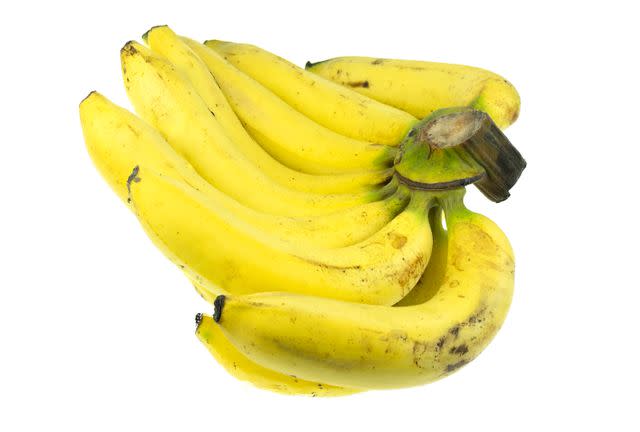
Getty Images / Thicha studio
The first banana America fell in love with, the Gros Michel is sometimes referred to as “Big Mike,” which is the English translation for this variety’s French name. As its name suggests, the Gros Michel banana can grow to be quite large and thick. With their firmer texture and slightly sweeter and floral taste, Gros Michel bananas are an ideal dessert banana that really shines in both dishes that need a banana punch with the intensity of banana Runts candy or that require the banana be cooked. Although gone from the mass market, Gros Michel bananas can still be purchased from online retailers who grow them on a much smaller scale.
Gros Michel bananas can be ordered online at Miami Fruit.
Cavendish Banana
Color: Yellow peel, white flesh
Flavor: Slightly sweet
Texture: Lightly creamy
Best Uses: Eaten raw, banana splits, banana pudding, or banana bread
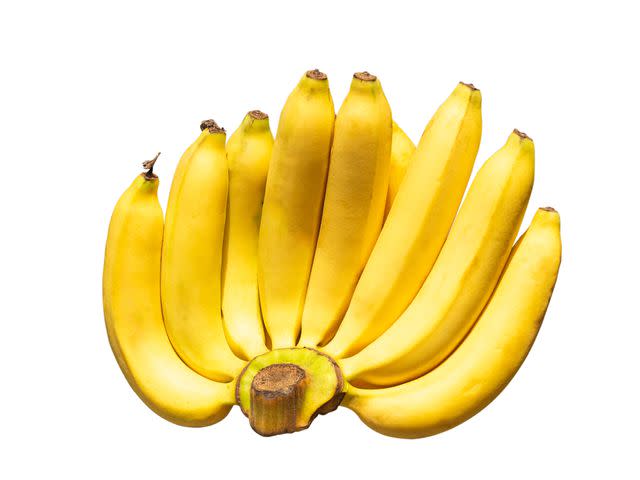
Getty Images / sutthichai somthong
The Cavendish, which is the banana most people are familiar with in the United States, accounts for 47% of all global production—significantly more than any other variety—and functions as the backbone of the banana business today. It’s no surprise why: Its sweet, well-rounded, and mildly fruity flavor make it an easy snack and versatile ingredient. Since it isn’t the densest banana out there, the Cavendish is a great choice for eating raw or incorporating into desserts like banana bread.
Nam Wah Banana
Color: Blackened, yellow peel, creamy flesh
Flavor: Sweet vanilla
Texture: Dense and creamy, almost silky
Best Uses: Eaten raw, smoothies, raw banana desserts
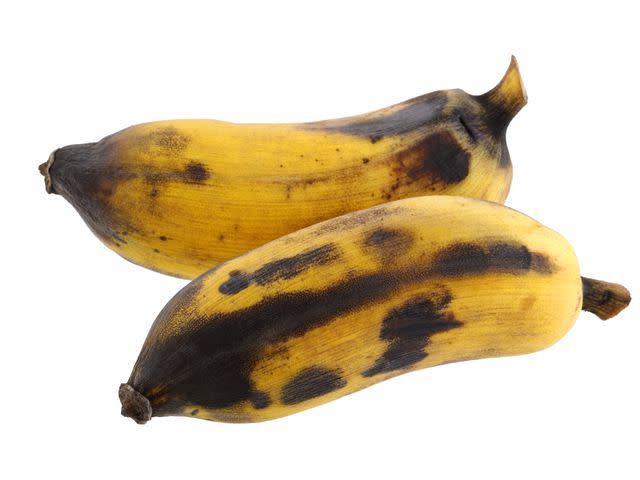
Getty Images / sasimoto
Unlike other banana varieties, Nam Wah bananas are ripe only once their peels have almost blackened entirely. Their flesh, however, will remain a light, creamy color. Nam Wah bananas are beloved for their exceptionally sweet flavor that’s reminiscent of vanilla. Combined with their silky smooth texture, these bananas are a delicious treat eaten on their own, but would also make an excellent choice for desserts like banana pudding or banana splits.
Nam Wah bananas can be ordered online at Fruit Hunters.
Mysore Banana
Color: Golden yellow peel, creamy flesh
Flavor: Very sweet
Texture: Very creamy
Best Uses: Eaten raw, smoothies, frozen and dipped in chocolate
Mysore bananas are characterized by their thin skins that appear almost golden when ripe, as well as their small stature. Due to their candy-like sweetness, Mysore bananas are a favorite among those who’ve tried them. Given their size and flavor, these bananas would be excellent for dipping in chocolate and freezing as a sweet snack.
When they’re in season, Mysore bananas can be ordered from Miami Fruit.
Pisang Raja Banana
Color: Yellow-orange peel, yellow flesh
Flavor: Sweet and slightly citrusy
Texture: Incredibly smooth
Best Uses: Eaten raw, banana splits
The Pisang Raja banana is known for its nearly starch-free texture once it ripens. This characteristic makes its flesh one of the creamiest bananas people can buy. Pisang Raja bananas’ slight citrusy note would make it an excellent addition to fruit salads, or even sliced and added as a pancake topping for a creamy, complex note.
The Pisang Raja banana can be ordered online from Miami Fruit.
Lady Finger Banana
Color: Light yellow peel, pale flesh
Flavor: Sweet, honey-like taste
Texture: Creamy
Best Uses: Left raw and used in desserts like banana splits or banana pudding
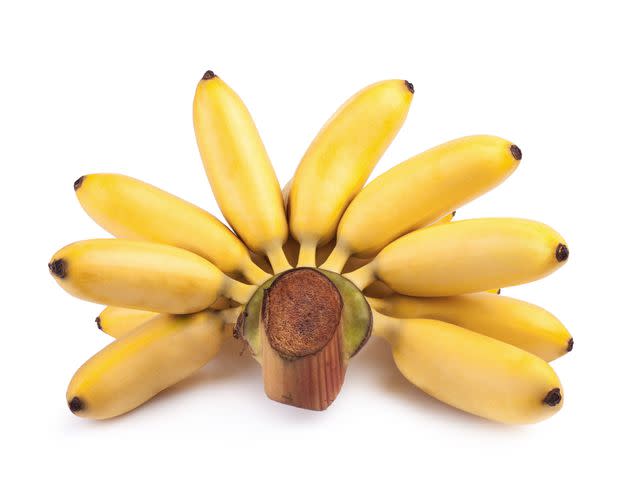
Getty Images / sirichai_asawalapsakul
Also known as sugar bananas, Lady Finger bananas are smaller and slightly sweeter than the familiar Cavendish. They are native to Southeast Asia and are commonly found in grocery stores within the Asia-Pacific region. Interestingly, Lady Finger bananas are resistant to browning once cut. Lady Finger bananas’ ability to stay visually appealing, along with their honey-like flavor, makes them a great choice for uncooked banana desserts and fruit salads.
Señorita Banana
Color: Light yellow peel, pale flesh
Flavor: Super sweet
Texture: Incredibly soft
Best Uses: Eaten raw or mashed and used in banana bread or banana cream pie
The Señorita banana, also referred to as the Monkoy or Arnibal banana, is native to the Philippines. They are renowned for their super sweet flavor and incredibly creamy texture. Although prized and delicious, Señorita bananas are typically too fragile to transport and are also vulnerable to a number of pathogens, which prevents their large-scale cultivation. They are typically found sparsely in rural areas, though some smaller retailers do harvest and offer them for sale in the Philippines.
Their absence on the mass market certainly doesn’t stop Filipinos and tourists from enjoying them, though. Due to their fragility and scarcity, they’re often eaten raw but would certainly make a welcome addition to sweet banana desserts that fully integrate the fruit, like banana bread or banana cream pie. Better yet, switching out the traditional Saba banana and accounting for the Señorita banana’s delicate texture could yield a particularly creamy adaptation of turon, a fried banana roll dessert native to the Philippines.
Red Bananas
Color: Red peel, pale to pinkish flesh
Flavor: Sweet
Texture: Creamy
Best Uses: Eaten raw, cooked and added to savory dishes
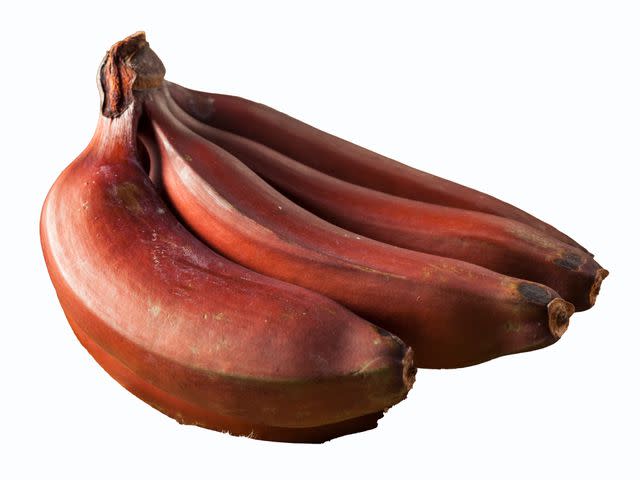
Getty Images / bhofack2
Red bananas are no stranger to the United States and are sometimes available at major supermarkets like Kroger and Walmart, and often found for sale through specialty online fruit suppliers, but they certainly deserve some more love and attention. In addition to being slightly sweeter than the already familiar Cavendish, red bananas are also denser and have firmer flesh, which makes them a good candidate for cooked dishes. In Thailand, for example, cooks frequently incorporate red bananas into curries to add sweetness and balance other flavors in the dish. Being sweeter and slightly creamier than the Cavendish, red bananas are also a good candidate for bananas Foster, a dish of flambéed bananas and vanilla ice cream.
Blue Java Banana
Color: Light yellow peel, pale flesh
Flavor: Slightly tart
Texture: Soft serve ice cream
Best Uses: Smoothies, mashed and used in banana bread
Blue Java bananas are sometimes referred to as “ice cream bananas,” but are neither blue nor taste like ice cream. While these bananas do have a blue tint to their skin when underripe, they brighten up to a pale yellow when fully ripened. The ice cream misnomer is likely due to their incredibly smooth, custard-like texture. While internet lore also claims these misunderstood bananas taste like vanilla, according to rare fruit seller Miami Fruit, this variety actually tastes slightly tart. Blue Java bananas, which are native to Southeast Asia, would be a welcome addition to smoothies or just enjoyed on their own.
Blue Java bananas can be ordered online from Miami Fruit.
Manzano Banana
Color: Dark yellow peel, pale flesh
Flavor: Sweet with a slight fruity flavor
Texture: Creamy
Best Uses: Smoothies, custards, desserts
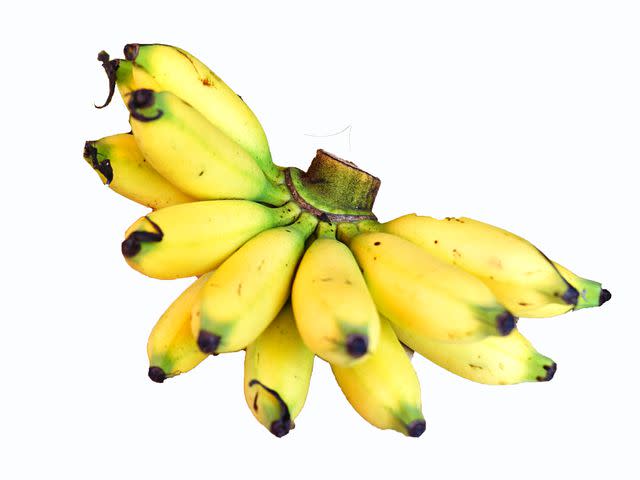
Getty Images / Yoyochow23
The Manzano banana is native to Central and South America, and reputed for its sweet, fruity flavor. With notes of apple and strawberry, it's often referred to as the apple banana. The riper it gets, the more intense its unique aroma becomes. Some swear that the Manzano is best enjoyed when its peel is speckled with dark spots or has turned completely black. In any case, a banana with a more noticeably complex flavor would make an excellent ingredient in smoothies, custards, or banana pudding.
Plantain
Color: Green, yellow, or black
Flavor: Mild to sweet
Texture: Firm to creamy
Best Uses: Savory dishes of all kinds
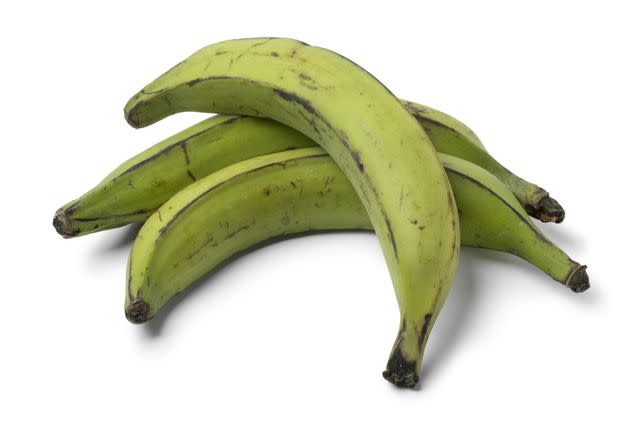
Getty Images / Picture Partners
Although not often thought of as typical bananas, plantains are part of the banana family—the biological genus Musa—and are certainly delicious in different ways than their dessert-oriented cousins. Better yet, they’re typically not too hard to find in the United States. Plantains’ higher starch content and lack of sweetness make them an excellent ingredient in savory dishes. Plantains are also an interesting ingredient because cultures around the world have ingeniously figured out how to prepare them at every stage of their ripeness. Just to give two examples, while underripe and green, plantains are destined to be sliced, smashed, and fried into tostones, which is a dish native to Latin America and the Caribbean, but when when fully ripened and black, plantains in the form of maduros are an excellent snack.
Read the original article on Serious Eats.

